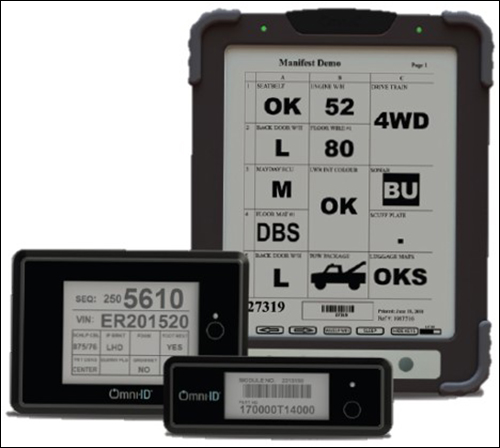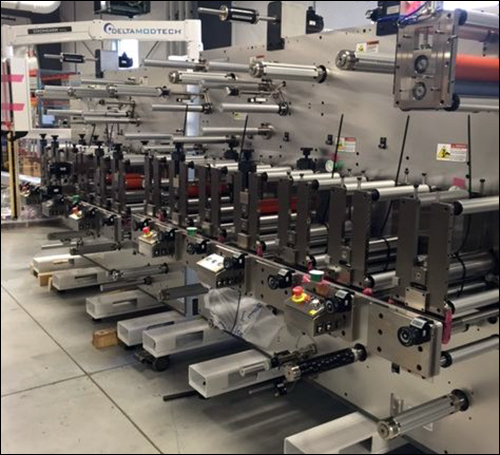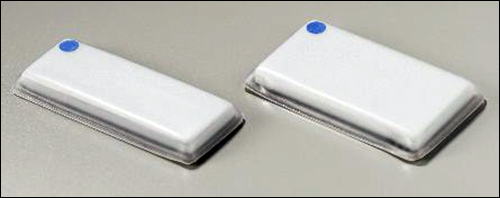The following are news announcements made during the past week by the following organizations:
Radley Corp., Omni-ID;
Metalcraft;
Thinfilm, Jones Packaging Inc;
Jadak, SkyeTek ;
DNP, Phoenix Solution;
ICA Nära Norrviken, Adfields;
Gentex, and TransCore.
Radley Adds Omni-ID RFID Technology to Its Solutions for Manufacturers
Radley Corp., a developer of software solutions for manufacturing companies, has announced a technology partnership with Omni-ID, a supplier of industrial RFID tags. Per the agreement, Radley is offering Omni-ID’s View tags and ProView visual tagging system, combined with Radley’s solutions for work-in-progress (WIP) tracking, product traceability and containerization/kitting.
Omni-ID’s ProView system consists of tags featuring a bistable LCD screen integrated with active and passive ultrahigh-frequency (UHF) RFID transponders, along with proprietary software to “link” components and provide tracking, visual instruction and two-way communication for production floors. Radley’s platform of products includes electronic data interchange (EDI), manufacturing execution systems (MES) and warehouse-management system (WMS) solutions, and can be integrated with business systems including large enterprise resource planning (ERP) and financial systems. By capturing data throughout the manufacturing process, whether utilizing traditional bar codes, machine integration or the use of RFID, Radley reports, customers can have access to real-time data across the supply chain.
“Radley’s manufacturing and warehouse solution suite continues to expand by bringing Omni-ID and their unique and innovative RFID technology into the fold,” said David Barks, Radley’s senior VP, in a prepared statement. “Omni-ID’s technology will enable our customers to collect more finite data with less human intervention, which will accelerate business processes and reduce errors.”
Radley expects to release the new system in early 2016 at this year’s RFID Journal LIVE! conference and exhibition, to be held in Orlando, Fla., on May 3-5. The company’s booth at the event will be #112.
Metalcraft Expands RFID Label Service
Metalcraft has announced that it has expanded its RFID converting and programming capabilities, and that it anticipates more than doubling its capacity to deliver RFID products in 2016. The company said it expects that the investment in new equipment and expanded staffing will reduce lead times on orders, while maintaining flexibility with custom RFID product designs.
Metalcraft has added its new Viper model to its family of converting equipment, which also includes the Predator, Crusader and Raptor. The Viper, the company explains, is a custom DeltaModTech machine that allows fast, accurate converting, including two-sided, variable labels and tags. Voyantic‘s latest Tagsurance unit verifies and ensures RFID tag quality, Metalcraft reports, and a new shingling conveyer offloads singular parts quickly.
“The machine was designed with flexibility in mind,” says Dean Hanson, Metalcraft’s senior VP of manufacturing, “to allow us to now only produce all of our current RFID products more effectively, but to also position us well for future designs and growth.” The machine, which supports a maximum web width of 10 inches, features an island placement station that can be repositioned to various locations on the machine for added flexibility. “This station allows us to accurately place the RFID inlay on the web during our converting process,” Hanson explains. “There are 13 die stations and 16 material and take-up spindles. The machine also features a variety of bull nose options that help us produce two-sided labels and tags. In addition, we will continually monitor the RFID tag quality with the latest Voyantic verification unit that can also be placed at any location along the web.”
Features of Metalcraft’s RFID converting service include subsurface printing of logos, copy, bar codes and other fixed or variable data; full encapsulation of high-frequency (HF) or ultrahigh-frequency (UHF) inlays in polyester, polypropylene, polyethylene or polycarbonate; die cut to a custom size; and customized attachment options, such as hangtags and isolated constructions for mounting to metal surfaces. The service also includes inlay programming for custom data, UPC or Electronic Product Code (EPC) codes with synchronization of the item’s printed image and post-programming data verification, as well as double-sided variable printing.
Thinfilm, Jones to Develop Smart Packaging for Pharmaceuticals
Thin Film Electronics (Thinfilm), a provider of printed electronics and smart systems, has announced a commercial partnership with Jones Packaging Inc., a provider of packaging solutions for health-care and consumer brands. The two companies are collaborating to integrate Thinfilm’s NFC OpenSense technology into paperboard pharmaceutical packaging and establish key manufacturing processes for production on Jones’ high-speed lines. Jones and Thinfilm are engaging leading global pharmaceutical companies to integrate the smart technology into product packaging and deliver the solution to market, the two companies indicate.
Jones and Thinfilm are initially focusing on integrating the NFC OpenSense technology into packaging solutions, such as paperboard cartons that house prescription and over-the-counter medications. As part of this initiative, the companies report, Jones has placed a six-figure unit order for NFC OpenSense tags.
NFC OpenSense tags are thin, flexible labels that can both detect a product’s “factory sealed” and “opened” states and wirelessly communicate contextual content with the tap of an NFC-enabled smartphone. The tags were initially designed for use on bottles, to authenticate a bottle’s contents or to indicate (when the tag is read) if its seal has been broken (see Thinfilm Launches OpenSense Printed NFC Sensor Label for Bottles). The tags contain unique identifiers that make it possible for pharmaceutical companies to authenticate products and track them to the individual item level using powerful software and analytics tools. In addition, according to Thinfilm and Jones, the tags remain active even after a product’s factory seal has been broken, empowering brands and medical personnel to extend the dialogue with consumers and patients.
A key feature of the NFC OpenSense tag is Thinfilm’s “Tag Talks First” protocol, which, according to Thinfilm, enables a read-speed that is up to 20 times faster than that of conventional NFC solutions. This makes it an ideal technology for use within the high-speed, high-volume production lines found in Jones’ manufacturing facilities, the two companies note. The work conducted by Jones and Thinfilm will also include the integration of ferrite shield labels with the NFC OpenSense tags. This will enable the NFC technology to function on metalized packaging, such as blisters commonly used for cold and flu medications.
The companies expect to complete much of the development, prototyping and testing by mid-year, and to commercially launch products during the fourth quarter of 2016. The Jones and Thinfilm smart packaging collaboration will be funded, in part, by grants from both the Swedish and Canadian governments.
Jadak Acquires SkyeTek
Jadak,
a supplier of RFID technologies for the medical, security, gaming and kiosk industries, has announced it has acquired SkyeTek, a provider of embedded and standalone ultrahigh-frequency (UHF) RFID solutions for OEM equipment suppliers. Jadak announced the acquisition, valued at $2.6 million in cash (subject to customary working capital adjustments), in mid-December 2015.
SkyeTek, based in Denver, Colo., specializes in UHF RFID technologies that maximize efficiency and visibility for OEMs serving the medical, pharmaceutical, government, hospitality and manufacturing industries. SkyeTek’s family of embedded and standalone UHF RFID modules are highly complementary to Jadak’s existing line of RFID solutions, Jadak reports. The SkyeTek team and facilities will stay in place, but “SkyeTek, as an entity name will be retired and will become Jadak,” says John Prior, Jadak’s marketing manager. “However, we will leverage the SkyeTek name as a sub-brand for our RFID product family,” Prior adds.
“The combination of SkyeTek with Jadak truly brings our RFID offering to new levels and enhances our value proposition with OEM customers in a variety of industries,” said Jeffrey Pine, Jadak’s VP of business development, in a prepared statement. “This is a particularly exciting development for our medical customers as they search for new strategies to improve patient safety, asset tracking and anti-counterfeiting within the hospital environment and throughout their supply chain.”
DNP, Phoenix Solution Announce New On-Metal RFID Tags
Japanese technology firms Dai Nippon Printing Co., Ltd. (DNP) and Phoenix Solution Co., Ltd. have announced the joint development of a series of EPC Gen 2 passive RFID tags that, according to the two companies, can be reliably read when attached to metal objects, even if a tag is affixed to the rear of a metal item, or is inserted between numerous metal parts.
The PMT series of tags, jointly developed by the two companies, uses the metal to which a tag is attached to help form an antenna, thereby facilitating non-contact communication via the electromagnetic waves generated by the metal itself. The tags are built using standard RFID chips supplied by NXP Semiconductors and Impinj (Phoenix Solution declines to identify the specific chips), support the EPC Gen 2 and ISO 18000-63 RFID standards, and offer 512 bits of memory. The PMT series includes the PMT-01W, which measures approximately 31 millimeters by 53 millimeters by 5 millimeters (1.2 inches by 2 inches by 0.2 inch), and the PMT-06W, which measures about 23 millimeters by 56 millimeters by 5 millimeters (0.9 inch by 2.2 inches by 0.2 inch).
All PMT tags are protected by waterproof and UV-resilient casings that, according to the companies, are flexible enough to be attached to curved surfaces, such as cylinders. They can be used on a variety of items, including anchor bolts, bicycles, golf club shafts, metal cages and metal cylinders. For example, the partners explain, if a PMT tag has been attached to the underside of a manhole cover, it is possible to read the tag from the road and confirm maintenance data without having to open the manhole. The tags will be available early next month, says Koji Wada, Phoenix Solutions’ deputy CEO.
Swedish Grocery Retailer ICA Nära Norrviken Tests NFC Price Labels
Swedish grocery store ICA Nära Norrviken has begun testing Near Field Communication (NFC) inlays integrated with pricing labels in a months-long trial that sends promotions, discounts and information about products to customers’ smartphones when they tap the phones against the NFC tags. The grocery store is working with Adfields, a media technology firm specializing in proximity marketing, which provided the NFC platform.
The NFC trial has been running since early December 2015 at a store in a northern suburb of Stockholm, and is expected to run for six months, according to Neil Smith, Adfields’ CTO. The tags—made with NXP Semiconductors‘ NTAG213 chip, which debuted in 2012 (see NXP Releases New NFC Tag Chips for New Applications)—are affixed to shelf edges and integrated with pricing labels. According to Smith, the NFC function is promoted by telling “customers to ‘blip here,’ a function that is becoming increasingly familiar to the Swedish public as NFC RFID technologies are rolled out on public transport and touch-to-pay credit card payments.” When a customer taps the label using his or her smartphone, the phone’s Web browser is directed to Adfields’ server, which then uploads the appropriate information to that individual’s device.
Tags on signs installed around the store inform customers about how to use the NFC technology, as well as how it is activated. Outside the store, customers can tap NFC smart posters in order to buy prepackaged grocery bags directly from their mobile devices.
The grocery store currently has 300 tags on display, Smith says, but plans are in place to expand that number throughout the course of the trial, and to optimize tag placement both inside and outside of the store. “As the trial progresses,” he states, “we will be revising the online content not only to keep it up to date, but also to keep it fresh and give customers an additional reason to continue using the technology.”
Gentex to Integrate TransCore’s Universal Toll Module in Rearview Mirrors
Gentex and TransCore have announced that they are teaming up to provide automotive manufacturers with a vehicle-integrated RFID tolling solution that enables motorists to drive on all U.S. toll roads without a traditional toll tag on their windshield. Currently, according to the two companies, more than 75 percent of new car registrations occur in states containing toll roads accessed by more than 50 million drivers annually.
Gentex and TransCore have signed an exclusive agreement to integrate TransCore’s Universal Toll Module (UTM) into Gentex’s electronic rearview mirrors. According to the two companies, the interior mirror is the optimal location for a vehicle-integrated toll transponder, eliminating the need to affix multiple toll tags to the windshield.
The UTM is designed to enable travel across all U.S. toll roads, the companies explains, so motorists do not need to have multiple RFID toll tags for different regions of the country, or to manage multiple toll accounts. Gentex’s vehicle-integrated solution simplifies and expedites local, regional and national travel. According to the two companies, the UTM is also designed to provide transportation agencies with an interoperability solution without necessitating costly infrastructure changes to the thousands of miles of toll lanes throughout the country.
In 2012, President Obama signed into law the Moving Ahead for Progress in the 21st Century Act (MAP-21). The act calls for the development of a nationally interoperable electronic toll-collection system by October 2016, the two companies report. Industry efforts are ongoing to establish standard tolling technology. Many toll roads within the United States use battery-powered transponders, but several U.S. tolling agencies are employing passive EPC Gen 2 RFID tags (see Efforts to Aid Adoption of ISO 18000-6C RFID for Toll Collection Move Forward). The International Bridge, Tunnel and Turnpike Association (IBTTA) seeks to establish a single tolling standard technology, and the outcome of that work might lead to an expansion in the use of passive EPC Gen 2 tags for tolling purposes (see Brazil’s Von Braun Labs Brings New Secure UHF Chip, Solutions to U.S.).





